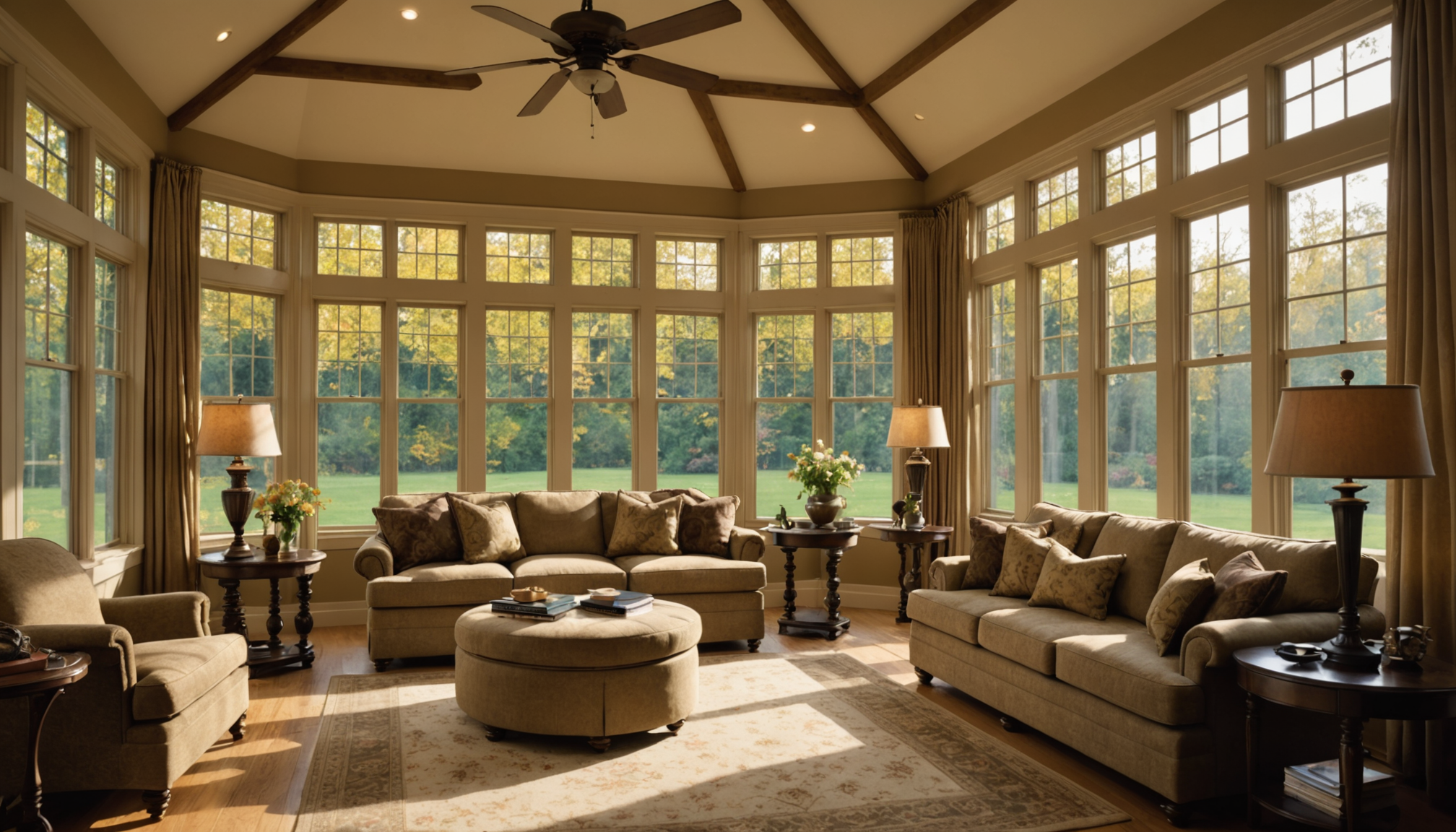When embarking on the journey of soundproofing your sunroom, selecting the appropriate materials is an essential first step. This choice can greatly impact the effectiveness of your efforts, the aesthetic appeal, and even the resale value of your home. Therefore, understanding the differences between various soundproofing materials will help you make an informed decision, optimizing both your budget and the tranquility of your sunroom.
Soundproofing materials generally fall into three major categories: sound blockers, sound absorbers, and vibration dampers. Each type serves a unique purpose in mitigating noise, and using a combination of these materials often yields the best results.
- Sound Blockers: These are dense materials designed to obstruct sound waves from penetrating walls, windows, and doors. Common materials include mass loaded vinyl (MLV), which is heavy and flexible, offering excellent noise reduction capabilities. Soundproof drywall is also a popular choice as it incorporates dense layers to prevent sound from transferring through walls.
- Sound Absorbers: Unlike sound blockers, absorbers are intended to control echo and reverberation within a room. Fiberglass insulation and acoustic panels are frequently used for this purpose, as they can trap and dissipate sound waves effectively.
- Vibration Dampers: These materials, such as green glue or acoustic caulk, minimize sound transmission by reducing vibrations. They are often used in conjunction with other soundproofing materials to enhance overall performance.
Several factors should be considered when choosing these materials for your sunroom:
| Factor | Description |
| Budget | Soundproofing materials vary significantly in price. Consider your budget carefully, as effective soundproofing solutions can range from economical to premium. |
| Aesthetic | Some materials can be bulky and may alter the appearance of your sunroom. Prioritize materials that blend well with your existing decor to maintain a visually appealing space. |
| Effectiveness | The noise level you wish to achieve will dictate the type and amount of material required. Evaluate your specific needs based on the level of noise present in your environment and your desired results. |
| Environmental Impact | Check for materials that are eco-friendly and have minimal environmental impact during production and installation. |
Lastly, consider consulting with a professional if you’re unsure about which materials to choose. A specialist can analyze your sunroom’s specific requirements, helping you select materials that not only address soundproofing concerns but also enhance the overall comfort and energy efficiency of the space. This approach ensures that your sunroom becomes a serene retreat for you and your family, improving both quality of life and home value.
Installing soundproof windows and doors
Installing soundproof windows and doors in your sunroom is a crucial step in ensuring that your efforts in creating a tranquil space pay off. These elements often represent the largest barrier against outdoor noise infiltrating your haven, and upgrading them can have a significant impact on the overall soundproofing effectiveness. Here’s how you can approach this installation process:
- Assess Existing Windows and Doors: Begin by evaluating your current windows and doors. Are they single-paned or made from materials that easily transmit sound? This will help you determine the most appropriate upgrades needed.
- Select Soundproof Windows:
- Double or Triple Glazed Windows: Opt for windows with multiple glass layers. These often include spacers filled with inert gases like argon to diminish noise transmission. The more layers, the better the sound insulation.
- Laminated Glass: Consider upgrading to laminated glass, which incorporates a polyvinyl butyral (PVB) layer between sheets of glass. This addition significantly reduces sound transmission and can enhance the security of your home as well.
- Choose Soundproof Doors:
- Solid Core Doors: Replace hollow core doors with solid core alternatives. These are much denser and far superior at blocking sound.
- Weather-Stripping and Seal Kits: Acquire appropriate weather-stripping materials to increase the airtight qualities of your new doors. This will prevent sound leaks and improve your sunroom’s energy efficiency as well.
- Professional Installation: While DIY can be tempting, professional installation of soundproof windows and doors ensures that they are fitted accurately and function optimally. This step is crucial to avoid any gaps or misalignments that could compromise soundproofing efforts.
- Inspect and Test: Once installed, inspect the perimeter of windows and doors to ensure there are no visible gaps. Conduct a simple noise test by having a family member create noise outside while you observe sound levels inside. This will help you assess the effectiveness of the installation, allowing for adjustments if necessary.
- Enhancements and Adjustments: If certain areas still allow more noise than desired, consider additional enhancements like heavy drapes or curtains. These can add an extra layer of sound absorption while also contributing to aesthetic appeal and potential heating efficiency.
By focusing on installing efficient soundproof windows and doors, you’re not only creating a peaceful retreat within your sunroom but also potentially increasing your home’s resale value. These upgrades enhance both the acoustic comfort and the energy performance of your space, making it attractive to potential buyers and beneficial for your well-being.
Utilizing sound-absorbing decor and furniture
One effective way to enhance the peacefulness of your sunroom is by thoughtfully incorporating sound-absorbing decor and furniture. This approach not only adds aesthetic value to your space but also significantly contributes to minimizing noise levels. By using specific types of furniture and decor, you can effectively decrease sound reflection and absorption, providing a quieter and more serene environment.
To begin with, consider incorporating plush, upholstered furniture, which plays a critical role in sound absorption. Sofas and chairs with thick cushions and fabric can absorb ambient noise, reducing echoes that make a space feel louder than it is. A large, comfortable sofa or a set of cushioned armchairs can help transform your sunroom into a cozy and quiet oasis, perfect for relaxation or family gatherings.
Rugs and carpets are also excellent tools for noise reduction. Laying down a thick, high-quality area rug can substantially decrease footstep sounds and other ambient noise, especially in spaces with hard flooring. You might choose a rug with a dense pile or one made from natural fibers like wool, which are known for their superior sound-absorbing qualities.
Wall hangings and tapestries offer another avenue to improve acoustics. These items serve a dual purpose: they can add visual interest and warmth to a sunroom while also dampening sound. By covering large areas of wall space with fabric-based art or decorative textiles, sound waves are less likely to bounce around, effectively reducing the overall noise level within your space.
You could also consider positioning bookshelves and cabinets strategically along certain walls. Filled with books and other items, these pieces of furniture act as sound barriers, preventing noise from traveling easily through your sunroom. They can be both functional and stylish, showcasing your personal collection of books or knickknacks while also enhancing privacy.
For the windows, installing heavy drapes or curtains can be a simple yet incredibly effective strategy. Fabrics like velvet, suede, or other heavy textiles are particularly adept at preventing sound from seeping in and out of your sunroom. This not only adds to your room’s soundproofing efforts but also contributes to the overall aesthetic and comfort, providing an element of luxury and opulence.
In addition to these home decor elements, consider acoustic panels if you face persistent noise challenges. Available in a range of designs, colors, and shapes, acoustic panels can be tastefully integrated into your sunroom’s design scheme and offer a significant reduction in sound reflection.
By carefully selecting and placing sound-absorbing decorations and furniture in your sunroom, you create a tranquil environment that can drastically improve daily life quality and potentially enhance the resale value of your home. This thoughtful approach to soundproofing not only enhances comfort and functionality but also enhances the overall acoustic environment, creating a peaceful retreat for everyone in the family.
Sealing gaps and cracks effectively
To ensure your sunroom maintains the peace and quiet you desire, it is crucial to pay close attention to sealing gaps and cracks. These openings may seem insignificant, but they can significantly undermine your soundproofing efforts by allowing sound waves to penetrate your sanctuary. By effectively addressing these vulnerabilities, you can vastly improve the tranquility of your space.
Start by tackling any visible gaps around windows and doors. These areas are typically the most prone to leaking sound, mainly because they are in constant use. A straightforward solution is to apply weather stripping along the edges and sill. This not only helps in minimizing sound infiltration but also boosts your sunroom’s energy efficiency, potentially increasing your home’s resale value. For any larger visible cracks, acoustic caulk can be your best friend. Unlike regular caulking materials, acoustic caulk is specifically designed to remain flexible, which allows it to maintain its sealing abilities as the building naturally expands and contracts over time.
Next, focus on the walls and ceiling. Inspect them carefully for any minor cracks or seams that might have gone unnoticed. Sealing these with an acoustic sealant can prevent sound from sneaking through and effectively improve the overall soundproof quality of your sunroom. Pay particular attention to areas around electrical outlets and light fixtures, as these can serve as hidden entry points for noise. Installing foam gaskets behind outlet and switch plates is an easy, cost-effective way to reduce sound leaks.
Don’t forget the floor, particularly if your sunroom is located on an upper level. Check for and seal any gaps around the baseboards. Consider using a draft stopper or door sweep for any doors leading into the sunroom. These will help block gaps at the bottom of doors, where sound often sneaks through unnoticed. Additionally, incorporating thick rugs or carpets can further help in absorbing sound, complementing your sealing efforts by reducing echo and negating footstep noises.
Implementing these meticulous techniques to seal gaps and cracks creates a more cohesive acoustic barrier for your sunroom. This, combined with other soundproofing measures, ensures your space remains a serene escape from external clamor. Not only does this approach improve everyday comfort, but it also enhances the appeal and potential value of your home should you decide to sell in the future. Whether for personal retreat or increased family harmony, ensuring your sunroom is a haven of quietude will undeniably enhance your living experience.
Enhancing floor and ceiling insulation
When considering the final touches in your journey toward a soundproof sunroom, enhancing your floor and ceiling insulation plays a pivotal role. While it’s easy to focus on walls, windows, and doors, neglecting the floor and ceiling can leave significant gaps in your soundproofing efforts. By improving insulation in these areas, you not only create a more complete acoustic barrier but also enhance the overall comfort and resale value of your home.
Start with the flooring options that can aid in soundproofing. If your sunroom has a hard surface like tile or wood, consider installing a subfloor with sound-dampening underlayment. Materials such as cork or rubber underlayment act as a cushion beneath the flooring, absorbing vibrations and reducing impact noise, such as footsteps, significantly. Alternatively, installing thick and plush carpeting with a quality carpet pad can add a substantial layer of sound insulation. This not only muffles noise but also adds a cozy, inviting atmosphere to your sunroom where everyone in the family can enjoy peace and quiet.
For those who prefer maintaining hard surfaces, area rugs can provide an aesthetic and functional solution. A strategically placed area rug over sound-reducing underlayer pads can further mitigate noise, complementing your existing decor while contributing to the room’s acoustic efficiency.
Turning our attention upward, ceiling insulation is equally crucial. Sound travels in all directions, and without adequate ceiling insulation, noise can easily pass through, disrupting the tranquility of your sunroom. If your ceiling is unfinished or simply under-insulated, consider using specialized acoustic ceiling panels or tiles. These are designed to absorb and dampen sound effectively. Alternatively, if you are open to structural changes, installing a suspended or drop ceiling with built-in acoustic properties can make a dramatic difference.
Another consideration, particularly important if your sunroom is located below an upper-level room, is the use of resilient channels. These are metal rails installed between drywall and the existing joists, creating a gap that reduces sound transmission through the ceiling by absorbing sound waves that would otherwise vibrate through the entire structure.
To further enhance both aesthetic and functional aspects, you might incorporate decorative elements like ceiling beams or coffers filled with insulation material. Not only do they act as additional sound barriers, but they also offer a sophisticated design element to your sunroom.
By meticulously enhancing both floor and ceiling insulation, your sunroom can transform into a peaceful retreat, shielded from intrusive outdoor noises. This attention to detail not only enriches your immediate living experience but also holds promise for increased overall property value. You can now enjoy a space that offers comfort, respite, and an inviting environment for gatherings or solitary moments alike.
Conclusion: Soundproofing your sunroom provides a multifaceted benefit, creating a serene environment for relaxation while potentially increasing your home’s resale value. By thoughtfully selecting materials, upgrading windows and doors, utilizing sound-absorbing decor, sealing gaps, and enhancing insulation, you can ensure your sunroom becomes a tranquil escape from the hustle and bustle outside, tailored perfectly for your family’s enjoyment.


